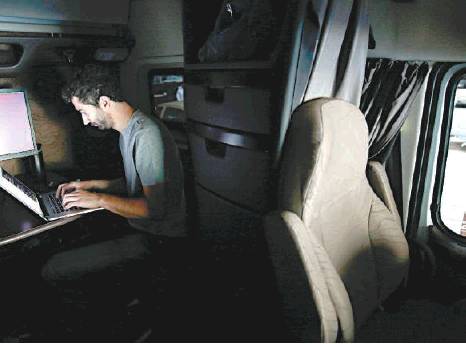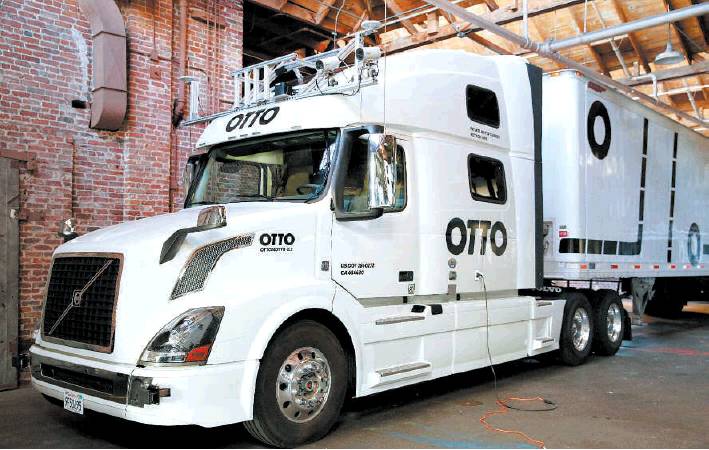Self-driving 18-wheelers may beat cars on roads, satisfy regulators
By John Markoff NEW YORK TIMES
SAN FRANCISCO — Imagine you are driving on a highway late at night when a big-rig truck closes in behind you. You relax because it is keeping a safe distance and seems to be obeying the speed limit. Now imagine that truck is driving itself.
Despite Silicon Valley’s enthusiasm for self-driving cars, it could be years before there are many of them on the road. But autonomous 18-wheelers? One startup is betting that is a different matter.
Otto, led by 15 former Google engineers, including major figures from the search company’s self-driving car and maps projects, is aiming at the long-haul freeway driving that is the bread and butter of the commercial trucking industry.
The engineers think that automating trucks rather than passenger vehicles could be more palatable financially and to regulators. Nationally, trucks drive 5.6 percent of all vehicle miles and are responsible for 9.5 percent of highway fatalities, according to Department of Transportation data.
Adding self-driving technology — at least as it stands now — into regular passenger cars could make them absurdly expensive for anyone without the cash of a Silicon Valley mogul. Until recently, the laser sensor used on the Google car project cost $75,000.
Those costs are coming down, but it will be some time before they have a realistic price for consumers. But a new, big tractor-trailer truck can easily cost more than $150,000, so the added cost of robotic features could make more sense. Plus, it could make trucking more efficient, allowing, for example, a human driver to rest in the sleeper cabin while the truck takes the wheel.
For now, the robot truckers would only take control on the highways, leaving humans to handle the tougher task of wending through city streets. The idea is similar to the automated pilots that fly jets at high altitudes while leaving the takeoffs and landings to humans.
“Our goal is to make trucks drive as humanly as possible, but with the reliability of machines,” Otto co-founder Anthony Levandowski says.
That objective probably won’t be reached for decades, despite the progress made with automated passenger vehicles over the past five years, predicts Steven Shladover, program manager for mobility at the University of California’s Partners for Advanced Transportation Technology. He maintains that the technology is still a long way from being reliable enough to convince government regulators that a robot can be entrusted to steer a truck traveling at highway speeds without causing a catastrophic accident.
“I don’t want to be on that highway when there is nobody there to take over a truck with 80,000 pounds of cargo, and I don’t think I know anyone else who would want to be,” Shladover says. “The consequences of any kind of failure in any component would be too severe.”
Autonomous vehicles have in recent years become one of the tech industry’s favorite projects. Uber sees them as a way to stop dealing with its pesky drivers. Tesla, along with other car manufacturers, sees autonomous technology as an important safety feature to help human drivers. Even Apple is thought to be working on some sort of self-driving car tech.
Google, in particular, has aggressively advocated and developed autonomous vehicle tech, and its self-driving cars are regularly seen on Bay Area roads and in Austin. The company also announced a deal earlier this month with Fiat Chrysler to install its technology in a fleet of minivans.
Since the Google car and map veterans, Anthony Levandowski and Lior Ron, founded Otto in January, the company has expanded to 41 employees and has been test-driving three Volvo trucks, logging in more than 10,000 miles. Over the weekend, it tested a self-driving truck in Nevada.
Otto went to Nevada because California’s self-driving regulations apply only to passenger cars, forbidding the technology from being used on public roads by commercial trucks or any vehicle exceeding 10,000 pounds.
California motor vehicle regulations prohibit Otto’s vision of a truck traveling on the freeway with only a sleeping driver in the cab, for example. But many states would permit that technical advance.
“Right now, if you want to drive across Texas with nobody at the wheel, you’re 100 percent legal,” said Levandowski, who as a Google engineer helped write draft legislation that permitted self-driving vehicles, which later became law in Nevada.
Otto is now looking for 1,000 truckers to volunteer to have self-driving kits installed on their cabs, at no cost, to help fine-tune the technology. The volunteer truckers would still be expected to seize the wheel and take control of the truck if the technology fails or the driving conditions make it unsafe to remain in autonomous mode, mirroring the laws governing tests of self-driving cars on public streets and highways.
Still, automating commercial driving is controversial and — potentially — a job killer. There are more than 3 million truck drivers in the United States, according to the American Trucking Associations, and about 1 in every 15 workers in the country is employed in the trucking business.
There is concern that if commercial trucking is completely automated, it would be economically devastating for small towns in America that thrive from supporting the long-haul trucking industry.
“The removal of truckers from freeways will have an effect on today’s towns similar to the effects the freeways themselves had on towns decades ago that had sprung up around bypassed stretches of early highways,” Scott Santens, an independent researcher, wrote in a blog post last year.
But the startup touts its technology as way to make up for a worsening shortage of truck drivers as more of them retire without enough younger drivers to replace them. Last year, the shortage stood at 47,500 and, unless recent trends change, will rise to nearly 175,000 by 2024, according to the American Trucking Associations.
The trade group hasn’t taken a stand on self-driving technology, but may draw up a policy later this year, said Dave Osiecki, executive vice president and chief of national advocacy.
“We are paying close attention because this could be huge for trucking in terms of labor costs and safety,” Osiecki says.
Otto co-founder Levandowski achieved some celebrity in 2004 while he was an industrial engineering graduate student at the University of California, Berkeley. He designed a self-driving motorcycle, stabilized by a gyroscope, that was entered in the Pentagon’s first autonomous vehicle contest. Later, his startup, 510 Systems, was acquired by Google when it began its self-driving car project.
He said that he had decided to leave Google because he was eager to commercialize a self-driving vehicle as quickly as possible.
“Google is very focused on doing what they’re doing, and I felt that it was time to see something come to market and I really liked the idea of bringing trucks to market,” he said.
Otto’s co-founder, Lior Ron, is also a veteran Google software engineer. With a background in Israeli army intelligence, he was originally the lead engineer for Google Maps. He also worked in the company’s Motorola mobile phone business for three years and then in its secretive robotics research effort.
But startup life is not like working for Google on its bucolic Silicon Valley campus.
Otto has set up shop in a rickety auto garage, close to a freeway entrance in San Francisco’s South of Market neighborhood. But the new office has enough space to house the firm’s three new Volvo trucks, which have been equipped with cameras, radars, and spinning laser sensors known as Lidar.
It is basically the same sensor array used on prototype vehicles being developed by Google, Nissan, Baidu and others. But Levandowski said that costly commercial trucks gave his designers more freedom to add high-quality sensors.
Otto will offer its technology as an upgrade that a long-haul truck owner could purchase, or perhaps as a service a trucking operator could subscribe to.
“Initially there will be certain roads that we know we can drive more safely,” Levandowski said. “On those roads, we’ll tell the driver, ‘You’re welcome to go take your nap or your break right now.’ If that’s 500 miles, that’s 10 hours, so he gets his full rest.”
The co-founders declined to reveal how much has been invested in the new company so far. They also would say only that they intend to “demonstrate commercial viability soon.”
A Silicon Valley startup called Peloton is focusing on truck convoys for fuel efficiency. Last year, Daimler Trucks North America demonstrated a self-driving truck in Nevada. Volvo and other truck manufacturers also have held autonomous freeway driving demonstrations in Europe.

